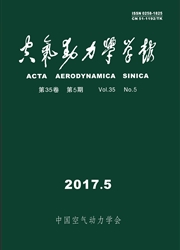

 中文摘要:
中文摘要:
应用CFD技术和气动声学时域理论(FW-H积分方程),探讨了空腔自激振荡发声机理。腔内噪声计算以空腔流动解为基础,采用了气动声学时域理论,对该理论进行了推导说明,并利用圆柱绕流声学特性验证该方法基本可行。研究获得的空腔自激振荡模态分析结果与Rossiter和Heller等的预测结果基本相同,捕捉到了自激振荡的频域特性;分析表明空腔上方形成的剪切层中的脱落涡与腔后壁相撞,产生的一次声波辐射至腔前壁激发新的脱落涡,新的脱落涡与腔后壁再次相撞产生二次声波形成的流动声学反馈回路是导致空腔自激振荡和噪声产生的主要原因,且腔内声压幅值主要出现在一阶和二阶振荡模态,声音能量主要集中在较低频率区域。
 英文摘要:
英文摘要:
By applying the CFD technology and the aeroacoustic theory in time domain(integral equations of Ffowcs-Williams and Hawings),analysis of sound generation induced by self-sustained oscillations inside a cavity has been performed.Utilizing the flow solution as the input data,the noise of the cavity is calculated by solving the Farassat acoustic formulation.The computational method validated by aeroacoustic characteristics of a column flow is feasible.The simulated self-sustained oscillation modes inside the cavity agree with Rossiter's and Heller's predicated results,which indicate their frequency characteristics.Moreover,the results indicate that the feedback mechanism that new shedding-vortexes induced by propagation of sound wave created by the impingement of the shedding-vortexes in the shear-layer and rear cavity face leads to self-sustained oscillations and noise generation inside the cavity.The peak sound pressure occurs in the first and second oscillation modes and the most of sound energy focuses on the low-frequency region.
 同期刊论文项目
同期刊论文项目
 同项目期刊论文
同项目期刊论文
 期刊信息
期刊信息
